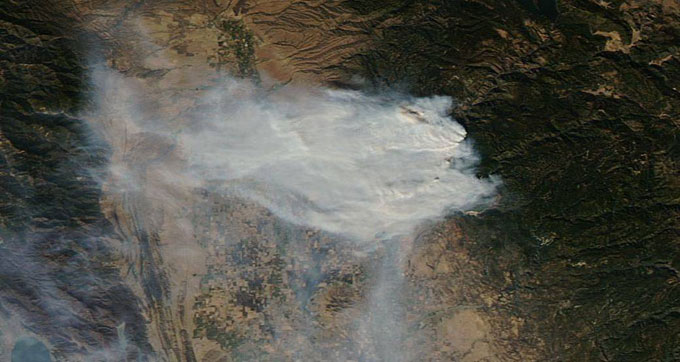 Now designated as California’s deadliest fire, the still-raging Camp Fire by November 13 had led to 42 deaths, with many residents still unaccounted for and more than 7,000 structures destroyed. (Image credit: NASA)
Now designated as California’s deadliest fire, the still-raging Camp Fire by November 13 had led to 42 deaths, with many residents still unaccounted for and more than 7,000 structures destroyed. (Image credit: NASA)This is the first entry in a Dana's new monthly column with Yale Climate Connections
 Now designated as California’s deadliest fire, the still-raging Camp Fire by November 13 had led to 42 deaths, with many residents still unaccounted for and more than 7,000 structures destroyed. (Image credit: NASA)
Now designated as California’s deadliest fire, the still-raging Camp Fire by November 13 had led to 42 deaths, with many residents still unaccounted for and more than 7,000 structures destroyed. (Image credit: NASA)
California has been ravaged by record wildfires in recent years. 2017 was the state’s costliest and most destructive fire season on record. The Mendocino wildfire in July 2018 was California’s largest-ever by a whopping 60 percent.
Even though California’s wildfire season has traditionally ended in October, the Camp Fire raging in November 2018 is the state’s most destructive on record.
The data tell the story: Six of California’s ten most destructive wildfires on record have now struck in just the past three years.
President Trump’s tweets suggesting forest mismanagement is to blame for California’s wildfire woes, and threatening to withhold federal funding, have prompted widespread rebukes for their insensitivity as thousands of citizens flee the fires – some, tragically, unsuccessfully – and as an affront to thousands of weary firefighters.
The reality is that about 57 percent of the state’s forests are owned and managed by the federal government, and another 40 percent by families, companies, and Native American tribes. Forest management does play some role in creating wildfire fuel, but some wildfires aren’t even located in forests. Moreover, scientific evidence clearly shows that climate change is exacerbating California’s wildfires in different ways:
Global warming causes higher temperatures, and 2014 through 2018 have been California’s five hottest years on record. This pattern leads to an increase in evapotranspiration – the combination of evaporation and transpiration transferring more moisture from land and water surfaces and plants to the atmosphere. Essentially, global warming causes plants and soil to dry out as the atmosphere holds more water vapor.
On top of this direct drying effect, climate change is causing a shift in rain patterns. Northern California has received only one inch of rain this season, which is about one-fifth of normal. A 2018 paper published in Nature Climate Change, led by UCLA’s Daniel Swain, found that as a result of global warming, California’s rainy season will become increasingly concentrated in the winter months between December and February. April, May, September, October, and November will become increasingly dry, meaning that the state’s wildfire season will start earlier and end later. As Swain noted in an informative Twitter thread about California’s November 2018 wildfires,
If Northern California had received anywhere near the typical amount of autumn precipitation this year (around 4-5 in. of rain near #CampFire point of origin), explosive fire behavior & stunning tragedy in #Paradise would almost certainly not have occurred.
With these hotter, drier conditions extending late into the year, wildfires have become larger, and they spread faster, cause more damage, and are more difficult to contain.
In a 2006 paper published in Geophysical Research letters, Berkeley scientists Norman Miller and Nicole Schlegel predicted that global warming would push the Southern California fire season associated with Santa Ana winds into the winter months. Those Santa Ana fires are especially costly because of the speed at which they spread due to the winds and because of their proximity to urban areas. The November 2018 Woolsey fire around Malibu and Thousand Oaks, California, is a tragic example.
Researchers of a 2015 study published in Environmental Research Letters, led by Yufang Jin at UC Davis, forecast that the area burned by Southern California wildfires will increase by about 70 percent by mid-century as a result of the drier, hotter, windier conditions caused by global warming. And these Southern California wildfires often occur outside of forests, according to the president of the Pasadena Fire Association.
Rutgers climate scientist Jennifer Francis over the past decade has been researching the connection between changes in the Arctic and extreme weather patterns throughout the Northern Hemisphere. In recent years a growing number of climate scientists have found evidence supporting her groundbreaking research.
The Northern Hemisphere jet stream is a result of the temperature difference between the cold Arctic and warmer lower latitudes in regions like North America and Europe. But the Arctic is the fastest-warming region on Earth, largely because as reflective sea ice disappears, the Arctic surface is increasingly covered by dark oceans that absorb more sunlight. The rapidly-warming Arctic is shrinking the temperature difference between that region and the lower latitudes, which in turn weakens the jet stream. As a result, rather than a fast-moving flow of air, the jet stream increasingly is taking a slow, meandering path across the Northern Hemisphere.
Posted by dana1981 on Wednesday, 14 November, 2018
 |
The Skeptical Science website by Skeptical Science is licensed under a Creative Commons Attribution 3.0 Unported License. |